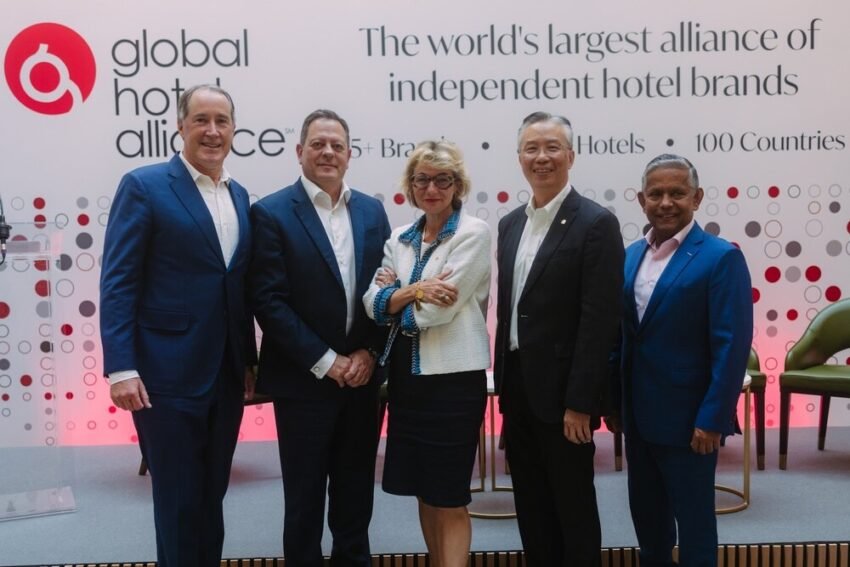Brand Stories
GHA Annual CEO Summit in Brussels Focuses on Strategic Growth, Resilient Travel Trends, and The Continued Success of Independent Hotel Brands Across Global Markets

Thursday, June 26, 2025
The GHA Annual CEO Summit in Brussels brought together industry leaders to discuss the path forward for the global hospitality sector, with a strong emphasis on strategic growth, resilient travel trends, and the continued success of independent hotel brands. As the travel industry recovers from past disruptions, the summit showcased optimism and proactive strategies, highlighting the expansion of GHA’s portfolio and the role of independent brands in shaping the future of global tourism. With a focus on adaptation, innovation, and collaboration, the summit underscored how GHA’s diverse range of independent hotel brands is thriving across key global markets, tapping into emerging opportunities while maintaining strong performance in established regions like Europe and the US. This event also reflected the overall resilience of the travel industry, as tourism continues to climb despite geopolitical tensions and economic challenges.
Global Hotel Alliance Unites Global Leaders to Chart Optimistic Future for Hospitality and Travel
The Global Hotel Alliance (GHA), the world’s largest alliance of independent hotel brands, gathered in Brussels for its annual CEO meeting, attracting over 30 top executives and senior representatives from across its portfolio of more than 45 global hotel brands. The event, hosted at the elegant Corinthia Hotel Brussels, was a remarkable showcase of the industry’s resilience and optimism despite ongoing challenges. The gathering, focused on the evolving global travel landscape, emphasized the importance of adaptability, resilience, and collaboration as essential drivers of success in the competitive hospitality sector.
As global travel trends continue to evolve, the leaders at the meeting agreed that the tourism sector is experiencing a robust recovery, with a strong upward trajectory evident in several regions. The panel discussion, “Navigating the Future of Travel,” led by GHA CEO Chris Hartley, offered valuable insights into the current state of the hospitality industry. The panel featured prominent CEOs, including Simon Naudi, Managing Director & Group CEO of Corinthia Group; Barbara Muckermann, Group CEO of Kempinski Hotels; Dillip Rajakarier, Group CEO of Minor Hotels; and Choe Peng Sum, CEO of Pan Pacific Hotels Group. Their conversation underscored the challenges of navigating geopolitical tensions, inflation, and shifting consumer expectations, while also highlighting the numerous growth opportunities on the horizon.
Travel Growth and Resilience Despite Challenges
Opening the event, Hartley referenced the latest data from UN Tourism, which revealed that over 300 million international tourists traveled globally in the first quarter of 2025, a 5% increase from the same period in 2024 and 3% above pre-pandemic levels. This positive performance occurred despite the geopolitical uncertainties and trade tensions that have affected the global economy, alongside the high costs of travel and tourism services driven by inflation.
Europe, a key driver of global tourism trends, welcomed 125 million international visitors during Q1 2025, marking a 2% increase over 2024. Popular destinations such as Spain, Turkey, Greece, Italy, and Portugal led the charge, posting impressive growth rates. Spain saw a 9% increase in arrivals, while Turkey’s growth was 7%, and countries like Greece, Italy, and Portugal each experienced a 4% rise in international visitors. France, too, recorded a solid 6% increase in tourist numbers, according to the May 2025 World Tourism Barometer from UN Tourism.
“We are operating in a volatile global environment, but as an industry, we have learned to adapt and stay agile in response to these fluctuations, and therefore remain optimistic,” said Chris Hartley, CEO of Global Hotel Alliance. “Travel demand is rising, particularly in the luxury and upscale segments where we specialise, and the strength of our alliance – driven by our loyalty platform, GHA DISCOVERY – positions our brands to capitalise on this momentum, particularly as many emerging growth markets are yet to reach their full potential.”
European and US Markets Continue to Lead Demand
Within GHA’s portfolio, Europe performed exceptionally well in 2024, with its 363 properties across 17 GHA brands generating $1.1 billion in revenue from GHA DISCOVERY loyalty members. European members were particularly active, spending a significant $733 million within the region and $417 million internationally. The US market continued to be a major contributor to hotel revenues, with all four CEOs on the panel confirming that American travelers were the largest source of international guest spend.
“One-third of our customers are from the US and this will remain a key market for us going forward,” revealed Simon Naudi, Managing Director & Group CEO Corinthia Group. “But we’re also focused on new markets in Asia. India and China have huge outbound potential, and we’re seeing more affluent travellers from these markets coming to Europe.”
In addition to these established markets, the alliance is keenly focused on the rising importance of the Asia-Pacific region. The first-quarter data from UN Tourism highlighted a 12% year-on-year increase in international arrivals to Asia and the Pacific, making it the fastest-growing region for global tourism. The panelists emphasized the immense potential in countries like China and India, where the growing middle class is increasingly eager to explore new experiences and destinations, representing a significant opportunity for expansion and growth in the region.
“The China and India outbound markets are exploding,” said Choe Peng Sum, CEO Pan Pacific Hotels Group. “Unless you know how to tap into those markets, particularly the FIT sector, you’ll miss out. That’s where the alliance can help. We can pivot, we can be nimble – and that’s key.”
The Advantage of GHA’s Unique Loyalty Ecosystem
An important discussion during the event was the value of being part of the GHA ecosystem. The CEOs spoke about the unique advantages of the alliance, where independent brands maintain their individual identities while benefiting from the collective power of the group. This collaborative approach not only increases the reach of each hotel brand but also provides a platform for repeat business and customer loyalty through the GHA DISCOVERY loyalty program.
“The beautiful part of the alliance is that our hotels retain their DNA,” said Choe. “For the guest, that’s powerful. And it works – in Tokyo, 70% of our bookings came through GHA DISCOVERY within three months of opening.”
Dillip Rajakarier, Group CEO Minor Hotels, which operates more than 300 hotels in Europe, added: “GHA DISCOVERY offers simplicity, choice, and value; guests can choose from 850 unique hotels around the world and earn DISCOVERY Dollars (D$) instead of complicated points, and that keeps them in the ecosystem, spending and staying with the growing number of hotels in the loyalty programme.”
This interconnected ecosystem has proven essential in driving resilience and sustained growth, enabling member brands to thrive amid the ever-changing landscape of the global hospitality market. The alliance continues to leverage its scale and reach, helping brands expand into new markets while ensuring their core values remain intact.
Strategic Expansion Across Key Global Markets
The CEOs shared exciting plans for continued expansion across various global markets. Corinthia, for example, recently unveiled new hotels in New York, Bucharest, and Brussels, with additional properties slated to open in Rome later this year. Meanwhile, Kempinski Hotels remains the leading luxury brand in Germany, resonating with clientele from the US, Middle East, and UK, and positioning itself for further growth.
Barbara Muckermann, CEO, Kempinski Hotels, noted that while global headwinds exist, the outlook is positive: “Whenever there’s uncertainty, there are opportunities. We are not seeing a slowdown in travel; in fact, we believe the next five years will be exceptionally strong for our industry. China is a sleeping giant, and it’s waking up.”
Minor Hotels, which already holds a dominant position in Spain, is expanding with 30 new hotels across Europe. Pan Pacific, leveraging the success of its high-performing flagship property in London, is set to extend its footprint across Europe, positioning itself as a key player in the luxury segment. These expansion efforts reflect the strong demand for quality hospitality services across various regions, ensuring the growth of GHA’s diverse portfolio.
Sustained Growth for 2025 and Beyond
Looking ahead, the outlook for the hospitality industry remains overwhelmingly positive. UN Tourism projects international arrivals will grow by 3% to 5% in 2025, and GHA is well-positioned to capitalize on this growth. With a remarkable performance in 2024, generating $2.7 billion in hotel stay revenue, the alliance’s growth trajectory has continued into 2025, with Q1 revenues up 15% to $746 million.
As part of its strategy for long-term growth, GHA has also welcomed new brands to its portfolio, including Cinnamon Hotels from Sri Lanka, Sunway Hotels from Malaysia, and Rotana from the UAE. With these additions, GHA is rapidly approaching the milestone of 1,000 properties across the globe, further strengthening its position as a leading player in the global hotel industry.
“Independent brands want to remain unique, but they also want reach – that’s what GHA offers,” said Hartley. “And as more travellers look for authentic, luxurious, and experiential stays, our model delivers exactly that.”
He added:“Our goal has always been to create value for our hotel brands and GHA DISCOVERY members alike. We’ve built a platform that’s simple, powerful, and growing fast, which is key to driving resilience and repeat guest revenue.”
The GHA Annual CEO Summit in Brussels centered on strategic growth, resilient travel trends, and the continued success of independent hotel brands, showcasing their strong performance and expansion across global markets, despite ongoing challenges.
Conclusion: A Bright Future for the Hospitality Sector
The Global Hotel Alliance’s annual CEO meeting in Brussels highlighted the remarkable resilience and optimism within the hospitality industry. With strong growth across established markets like the US and Europe, as well as significant opportunities in Asia, GHA’s portfolio is poised to continue thriving in 2025 and beyond. The continued success of its member brands and the collective strength of the alliance’s loyalty program ensure that GHA is well-equipped to navigate the challenges of the evolving global travel landscape. With strategic expansions, a strong loyalty ecosystem, and a commitment to innovation, the alliance is set for an exciting future in the dynamic world of hospitality.
Tags: Asia-Pacific growth, Brussels, CEO meeting, Corinthia Group, emerging markets, European tourism, GHA, gHA Discovery, global hotel alliance, Hospitality Industry, hotel revenue, independent hotel brands, Kempinski Hotels, Minor Hotels, pan pacific hotels, Tourism Trends, Travel Growth, UN Tourism data, US market
Brand Stories
Cohen & Steers tips power demand from data centres to cope with the artificial intelligence boom

Utilities are among the top picks for international investment group Cohen & Steers as it reshuffles its holdings to minimise the impact of global tariffs and bets on rising demand for power from data centres to cope with the artificial intelligence boom.
“Utilities tend to have very little impact from tariffs,” said Ben Morton, the New York-based head of global infrastructure for the $US88 billion ($136 billion) asset manager during a trip to Sydney to meet with local investors.
Loading…
Brand Stories
Fashion Brands and Hotels Team Up for the Hottest Travel Collaborations of Summer 2025 – L'OFFICIEL USA
Brand Stories
How to create passive income in 2025 with AI

Artificial intelligence is no longer a futuristic concept; it’s a powerful tool that can be leveraged today to build scalable and sustainable passive income streams. In 2025, with AI becoming more accessible and sophisticated, the opportunities for automation and monetization are more significant than ever. Here’s a detailed guide on how to create passive income using AI.
1. AI-Powered Content Creation and Monetization
Content creation is one of the most accessible and effective ways to generate passive income with AI. The key is to use AI to handle the heavy lifting of production, allowing you to focus on strategy and quality control.
Blogging and SEO:
Automated Content Generation: Use AI writing tools like Jasper, Copy.ai, or a custom GPT to generate blog posts, articles, and guides on a massive scale. You can feed the AI a topic and a few keywords, and it can produce a well-structured draft in minutes.
SEO Optimization:AI tools can also help with keyword research, meta descriptions, and on-page SEO. This ensures your content is not only abundant but also optimized to rank highly on search engines, driving organic traffic and passive ad or affiliate revenue.
Affiliate Marketing:Integrate affiliate links into your AI-generated content. Once the blog post is live and attracting readers, it can generate commissions from product sales with no further effort from you.
Faceless YouTube Channels:
Scripting and Video Production: AI can write engaging scripts for videos in a specific niche (e.g., finance, history, or self-improvement).
Voiceovers and Visuals:Use AI-powered text-to-speech generators like ElevenLabs for professional-sounding voiceovers. Combine this with AI video generators or stock footage to create compelling videos without ever showing your face or recording a single line of dialogue.
Monetization: Once your channel is established, you can earn passive income through YouTube’s Partner Program (ad revenue) and by including affiliate links in your video descriptions.
Selling AI-Generated Digital Products:
E-books and Planners: Use AI to write e-books on niche topics, or create unique digital planners and journals. You can then sell these products on platforms like Etsy or Gumroad.
Print-on-Demand (POD): AI image generators like Midjourney or DALL-E can produce stunning and unique art. You can use these designs on t-shirts, mugs, and posters and sell them through POD services like Printful or Printify. The platform handles production and shipping, making it a completely passive income stream after the initial design and setup.
2. AI-Driven E-commerce and Dropshipping
AI can automate and optimize every step of an e-commerce business, from product selection to marketing.
Dropshipping with AI: AI tools can analyze market trends to help you identify winning products to sell. They can also generate product descriptions and marketing copy, and even automate ad campaigns on platforms like Facebook and Instagram.
Automated E-commerce Stores: Platforms like Shopify offer AI-powered store builders that can get you up and running in a day. You can use AI to manage inventory, forecast demand, and provide personalized product recommendations to customers, all of which contribute to a more passive operation.
3. AI-Powered Services and Automation for Businesses
You can sell AI-powered solutions to other businesses, creating a recurring revenue model.
Building Custom Chatbots:Many small to medium-sized businesses need chatbots for their websites to handle customer inquiries, book appointments, or qualify leads. You can use no-code AI tools to build and deploy these chatbots and charge businesses a monthly fee for the service and maintenance.
AI-Powered Social Media Management: Offer a subscription-based service where AI tools generate and schedule social media content for clients. The AI can analyze their target audience and industry trends to create relevant and engaging posts, all with minimal input from you once the system is configured.
AI Consulting and Workflow Automation: As more businesses adopt AI, they’ll need help integrating it into their workflows. You can offer consulting services to help companies identify opportunities for AI integration, build custom automation workflows using tools like Zapier or Make, and charge a premium for your expertise.
4. Leveraging AI for Financial Strategies
AI can also be applied to financial markets to generate passive income.
Algorithmic Trading: While this requires a higher level of expertise, AI and machine learning are used to develop trading bots that can analyze market data and execute trades automatically. These bots can be configured to operate based on your specific risk tolerance and investment goals.
Predictive Analytics for Investment: Use AI to analyze market trends and predict potential growth areas. While this isn’t a direct income stream, it can guide your investment decisions and lead to significant passive returns over time.
The key to creating passive income with AI in 2025 is to see AI as a powerful partner that handles repetitive, time-consuming tasks. By building a system where AI does the work, you can create and manage income streams that require very little active involvement, ultimately freeing up your time and generating wealth.
-

 Brand Stories2 weeks ago
Brand Stories2 weeks agoBloom Hotels: A Modern Vision of Hospitality Redefining Travel
-

 Brand Stories1 week ago
Brand Stories1 week agoCheQin.ai sets a new standard for hotel booking with its AI capabilities: empowering travellers to bargain, choose the best, and book with clarity.
-

 Destinations & Things To Do2 weeks ago
Destinations & Things To Do2 weeks agoUntouched Destinations: Stunning Hidden Gems You Must Visit
-

 Destinations & Things To Do1 week ago
Destinations & Things To Do1 week agoThis Hidden Beach in India Glows at Night-But Only in One Secret Season
-

 AI in Travel2 weeks ago
AI in Travel2 weeks agoAI Travel Revolution: Must-Have Guide to the Best Experience
-

 Brand Stories4 weeks ago
Brand Stories4 weeks agoVoice AI Startup ElevenLabs Plans to Add Hubs Around the World
-

 Brand Stories3 weeks ago
Brand Stories3 weeks agoHow Elon Musk’s rogue Grok chatbot became a cautionary AI tale
-

 Asia Travel Pulse4 weeks ago
Asia Travel Pulse4 weeks agoLooking For Adventure In Asia? Here Are 7 Epic Destinations You Need To Experience At Least Once – Zee News
-

 AI in Travel4 weeks ago
AI in Travel4 weeks ago‘Will AI take my job?’ A trip to a Beijing fortune-telling bar to see what lies ahead | China
-

 Brand Stories4 weeks ago
Brand Stories4 weeks agoChatGPT — the last of the great romantics














